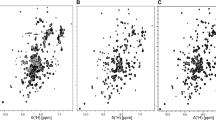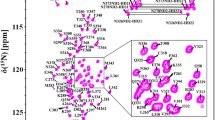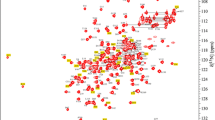Abstract
Retinoic acid-induced protein 2 is a human protein of 530 residues encoded by the RAI2 gene (Q9Y5P3; RAI2_HUMAN). RAI2 is a novel tumor suppressor protein whose depletion in breast cancer cell lines results in the downregulation of several genes associated with differentiation along with increased invasiveness and aggressive tumor phenotype of the cells. The role of the protein is specified to be a transcriptional regulator that promotes chromosomal stability and hence controls the expression of several regulators of cancer and metastasis. Structurally, RAI2 remains an unknown entity and, hence, to obtain a detailed view on the structure function relationship we report the 1H, 13C, and 15N resonance assignments for the backbone and side chain nuclei of the C-terminal region (a.a. 303–451 of UniProt Q9Y5P3) of RAI2.



Similar content being viewed by others
References
Bax A, Ikura M (1991) An efficient 3D NMR technique for correlating the proton and 15N backbone amide resonances with the alpha-carbon of the preceding residue in uniformly 15N/13C enriched proteins. J Biomol NMR 1:99–104
Bracken C, Palmer AG 3rd, Cavanagh J (1997) (H)N(COCA)NH and HN(COCA)NH experiments for 1H-15N backbone assignments in 13C/15N-labeled proteins. J Biomol NMR 9:94–100
Clubb RT, Thanabal V, Wagner G (1992) A constant-time 3-Dimensional triple-resonance pulse scheme to correlate intraresidue H-1(N), N-15, and C-13’ chemical-shifts in N-15-C-13-labeled proteins. J Magn Reson 97:213–217
Erdős G, Dosztányi Z (2020) Analyzing protein disorder with IUPred2A. Curr Protoc Bioinf 70(1):e99
Grzesiek S, Bax A (1993) Amino acid type determination in the sequential assignment procedure of uniformly 13C/15N-enriched proteins. J Biomol NMR 3:185–204
Guntert P, Buchner L (2015) Combined automated NOE assignment and structure calculation with CYANA. J Biomol NMR 62:453–471. doi:https://doi.org/10.1007/s10858-015-9924-9
Hafsa NE, Arndt D, Wishart DS (2015) CSI 3.0: a web server for identifying secondary and super-secondary structure in proteins using NMR chemical shifts. Nucleic Acids Res 43:W370–W377. doi:https://doi.org/10.1093/nar/gkv494
Kay LE, Ikura M, Tschudin R, Bax A (1990) 3-Dimensional triple-resonance NMR-spectroscopy of isotopically enriched proteins. J Magn Reson 89:496–514
Keller RLJ (2004) Computer aided resonance assignment tutorial. Cantina, Goldau
Marion D, Driscoll PC, Kay LE, Wingfield PT, Bax A, Gronenborn AM, Clore GM (1989) Overcoming the overlap problem in the assignment of 1H NMR spectra of larger proteins by use of three-dimensional heteronuclear 1H-15N Hartmann-Hahn-multiple quantum coherence and nuclear Overhauser-multiple quantum coherence spectroscopy: application to interleukin 1 beta. Biochemistry 28:6150–6156
Mészáros B, Erdős G, Dosztányi Z (2018) IUPred2A: context-dependent prediction of protein disorder as a function of redox state and protein binding. Nucleic Acids Res 46(W1):W329–W337
Montelione G, Lyons BA, Emerson SD, Tashiro M, Montelione GT, Tashiro M (1992) An efficient triple resonance experiment using carbon-13 isotropic mixing for determining sequence-specific resonance assignments of isotopically-enriched proteins. J Am Chem Soc 114:10974–10975
Vranken WF, Boucher W, Stevens TJ, Fogh RH, Pajon A, Llinas M, Ulrich EL, Markley JL, Ionides J, Laue ED (2005) The CCPN data model for NMR spectroscopy: development of a software pipeline. Proteins 59:687–696. doi:https://doi.org/10.1002/prot.20449
Walpole SM, Hiriyana KT, Nicolaou A, Bingham EL, Durham J, Vaudin M, Ross MT, Yates JRW, Sieving PA, Trump D (1999) Identification and characterization of the human homologue (RAI2) of a mouse retinoic acid-induced gene in Xp22. Genomics 55:275–283. doi:https://doi.org/10.1006/geno.1998.5667
Werner S, Brors B, Eick J, Marques E, Pogenberg V, Parret A, Kemming D, Wood AW, Edgren H, Neubauer H, Streichert T, Riethdorf S, Bedi U, Baccelli I, Jücker M, Eils R, Fehm T, Trumpp A, Johnsen SA, Klefström J, Wilmanns M, Müller V, Pantel K, Wikman H (2015) Suppression of early hematogenous dissemination of human breast cancer cells to bone marrow by retinoic acid-induced 2. Cancer Discov 5:506–519. https://doi.org/10.1158/2159-8290.CD-14-1042
Wittekind M, Mueller L (1993) HNCACB: a high-sensitivity 3D NMR experiment to correlate amide proton and nitrogen resonances with the alpha-carbon and beta-carbon resonances in proteins. J Magn Reson B 101:201–205
CSI-3.0 webserver at csi3. wishartlab.com/cgi-bin/index.php
Acknowledgements
The FLI is a member of the Leibniz Association (WGL) and is financially supported by the Federal Government of Germany and the State of Thuringia.
Author information
Authors and Affiliations
Corresponding author
Additional information
Publisher's Note
Springer Nature remains neutral with regard to jurisdictional claims in published maps and institutional affiliations.
Rights and permissions
About this article
Cite this article
Lang, A., Goradia, N., Wikman, H. et al. 1H, 13C, and 15N backbone assignments of the C-terminal region of the human retinoic acid-induced protein 2. Biomol NMR Assign 14, 271–275 (2020). https://doi.org/10.1007/s12104-020-09960-9
Received:
Accepted:
Published:
Issue Date:
DOI: https://doi.org/10.1007/s12104-020-09960-9




